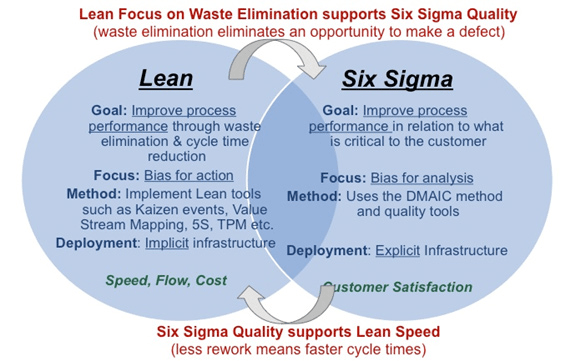There have been debates when it comes to Lean and Six Sigma, in the business world. Most individuals have solid views about which method is more functional for removing waste and cutting costs. Six Sigma is a set of methods that attempt to greatly decrease the rate of defects, while Lean manufacturing is an organized way of eradicating waste and making a flow in the production process.
Basically, Six Sigma vs Lean systems have similar aim. These methods both strive to eradicate waste and make the most effective system possible, but they both take different tactics toward attaining this target..
Lean Manufacturing
Lean manufacturing has been in use for a long time, the ideas behind it were firstly introduced by Henry Ford who liked to have the production standards extremely high so that every step flowed naturally into the next, hence resulting in little waste.
The Lean system categorizes seven areas of waste that are often common in production systems
- Overproduction
- Waiting
- Transport
- Motion
- Over-processing
- Inventory
- Defects
The Implementation of Lean will make staff move materials as little as possible to eliminate the waste of motion. It also deals with quality matters during the course of manufacturing, which saves both resources and time because staffs aren’t scrambling to fix errors later.
Six Sigma
Six Sigma was introduced by Bill Smith, an engineer for Motorola in the 1980’s. Bill believed that by eliminating variation one can improve the experience of customers and increase your total savings.
Six Sigma seeks to decrease waste and it describes a defect as anything which doesn’t meet the expectations of the customer. It places emphases more on eradicating any variation in the process to lower the amount of defects.
Six Sigma has assisted Motorola saving millions of dollars in cost. Many other companies like, Toshiba, General Electric, Intel, and Bank of America have all adopted Six Sigma principles after observing Motorola’s success and has seen dramatic improvements as well.
One major difference between the Lean system and Six Sigma is the fact that each method implements way of process development but with a different process. Six Sigma does this mainly by using DMAIC which stands for
- Define
- Measure
- Analysis
- Improvement
- Control
Lean vs Six Sigma
Although we are comparing Lean vs Six Sigma, the fact is they both function toward similar ultimate goals which are eradicating waste and creating effective processes. They just make use of different approaches to achieve this. Lean emphasizes on evaluating workflow to decrease cycle time and eradicate waste. Lean, while using very little resources tries to exploit value to the customer. Six Sigma strives for almost perfect results that will lessen costs and achieve greater levels of customer satisfaction.
To cut everything short, the main difference between Lean vs Six Sigma is that lean focuses on ways to increase flow while Six Sigma emphasizes on realizing consistent results. A similarity between Lean and Six Sigma is that they both have proven that it is possible to radically advance the quality of your customer experience and products by improving the processes. As a matter of fact, the problem may not be whether people should adopt the Lean system or the Six Sigma system, but how they can take the elements they prefer from each one of them and make use of what they have taken to solve the issues in their own business.
Most of the time, we hear about the amazing changes businesses have gotten using either Lean or Six Sigma. But yet, the actuality is that most companies that don’t use any will fail. Every time a new Lean or Six Sigma project is in progress there is always a first wave of energy and enthusiasm. If this is not maintained throughout the project, it is likely it will not achieve the result which was aimed for. Also if organisations don’t have the capability to maintain the changes made, they often end up moving back to the former ineffective processes they had before the project began.






